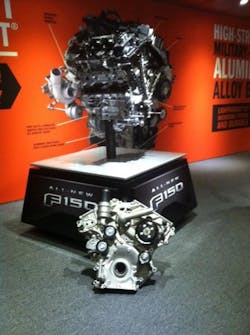Mirroring a trend occurring in the Class 8 heavy truck segment, smaller displacement engines are being developed for the light truck market as OEMs try to boost fuel economy without sacrificing performance.
The most recent example is Ford Motor Co.’s new gasoline-fired 2.7 liter V6 EcoBoost engine shown off at the OEM’s recent roundup event in Texas to highlight its new 2015 model F-150 pickups.Ed Waszczenko, engine design manager for Ford’s 2.7 liter platform, told Fleet Owner that this new engine represents a “clean sheet of paper” design incorporating in some places diesel technology.
“We developed ‘diesel-like’ connecting rods capable of handling not only higher pressures but allowing the [2.7 liter] engine to fit into a smaller space,” he said.
The offset I-beam piston connecting rods help give the 2.7 liter (seen at right) a compression ratio of 10 to 1 while shrinking its height by two inches, Waszczenko said.
Weighing in at around 500 lbs., Ford’s new 2.7 liter generates 325 hp and 375 lbs.-ft. of peak torque, providing 2015 model F-150s 2.250 lbs. of payload hauling capacity and 8,500 lbs. of towing capacity.
Though Environmental Protection Agency (EPA) fuel economy testing numbers for the 2.7 liter – indeed, for the new 2015 model F-150 line as a whole – won’t be finalized until November, Waszczenko noted that several key design features help improve this engine’s fuel economy profile.
For starters, the 2.7 liter’s twin turbochargers – a standard element on the Ford EcoBoost V6 platform – are located much closer to the engine’s exhaust ports to reduce “turbo lag” and improve “time of torque” engine response.
Waszczenko added that Ford developed a patent-pending coolant plumbing system for the turbochargers to draw “hot” oil and coolant out from them when the engine is stopped, reducing turbocharger “heat soak” and by extension help improve fuel economy by reducing heat-related power losses.
The 2.7 liter also features a variable displacement oil pump to match oil volume precisely to engine demand, helping reduce parasitic engine power losses, he pointed out – noting that, as with all EcoBoost variants, the 2.7 liter requires 6 quarts of 5W-30 engine oil.
Waszczenko also emphasized that other improvements to the 2.7 liter – from using composite oil pan and camshaft covers to reduce weight along with an automatic engine start/stop featured (disabled when in 4x4 and tow mode) – are all aimed at improving fuel efficiency without reducing the engine’s performance profile.
Indeed, Brian Bell, product marketing manager for the F-150, noted that the standard “start/stop” feature on the 2.7 liter can improve fuel economy up to 1 mpg in city driving.
And Waszczenko added that specially-coating bearings within the 2.7 liter protect the engine against “seizing up” when engaged in frequent start/stop operation.
“It’s designed to be a lighter commercial-grade engine that delivers full-size pickup power with midsize pickup fuel economy,” he explained.
The same thinking is being applied at Chrysler’s Ram Trucks division as well, particularly where its new 3.0-liter “EcoDiesel” V6 engine is concerned.
Rolled out last year as an option for its 2015 model Ram 1500 pickup (seen below at left), Chrysler said this week it would boost production of its diesel powertrain mix to 20% of total Ram 1500 production volume, thus powering one out of every five Ram 1500 units built — double the OEM’s initial expectation, noted Bob Hegbloom, recently promoted to president and CEO at Ram Truck.The 3.0-liter engine is a turbocharged dual overhead camshaft (DOHC) 24-valve V-6 that produces 240 hp and 420 lb.-ft. of peak torque, providing for 9,200 pounds of towing capacity and fuel economy of 28 mpg on the highway.
Manufactured by Fiat Group Automobiles’ VM Motori in Cento, Italy – an engine supplier to Chrysler since 1992 – Hegbloom described the capabilities and fuel efficiency offered by the 3.0-lite small block diesel as a “game-changer” for the light truck segment.
“It’s what our customers have been asking for: a small displacement diesel engine with the power and capability of a V8 but with V6 fuel economy,” he explained in an interview earlier this year.
The small displacement diesel’s advantage is its low-end torque. “Even when towing fully loaded, it’s not doing it in ‘boosted’ mode, so you’re not drinking extra fuel,” Hegbloom added. “And the fuel economy people are experiencing with this [in tow mode] is greater than what a V8 gets when unloaded. It’s what our light truck customers have been looking for.”
About the Author
Sean Kilcarr
Editor in Chief
Sean Kilcarr is a former longtime FleetOwner senior editor who wrote for the publication from 2000 to 2018. He served as editor-in-chief from 2017 to 2018.


